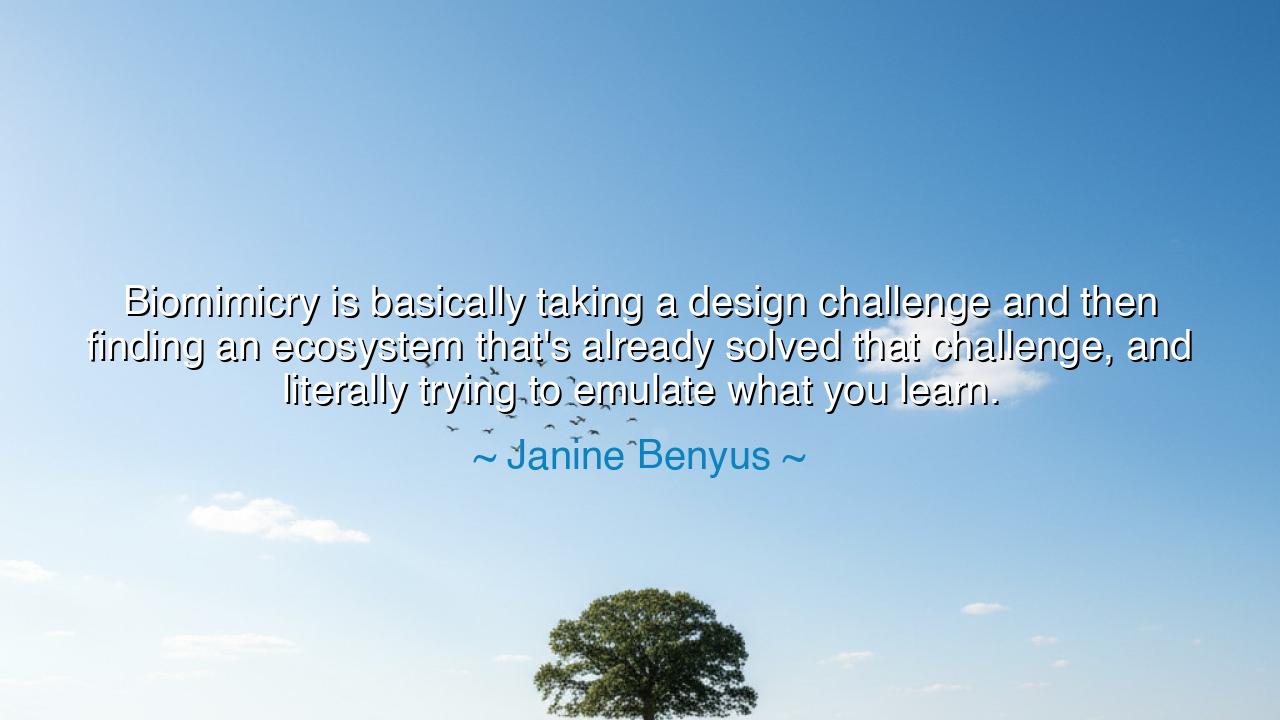
Biomimicry is basically taking a design challenge and then
Biomimicry is basically taking a design challenge and then finding an ecosystem that's already solved that challenge, and literally trying to emulate what you learn.






When Janine Benyus declared, “Biomimicry is basically taking a design challenge and then finding an ecosystem that's already solved that challenge, and literally trying to emulate what you learn,” she spoke as both a visionary and a student of nature. Her words rise with the quiet authority of one who has observed the world with both curiosity and reverence. She reminds us that nature is the supreme teacher, and that the wisdom of millennia is written not in books or in human invention, but in the patterns of rivers, the flight of birds, the architecture of leaves, and the flow of energy through living systems. To design with insight, she says, is to listen to these lessons and apply them, turning the elegance of the natural world into solutions for human challenges.
Benyus’ concept of biomimicry emerged in a time when human innovation often clashed with the environment. We built machines that drained rivers, engineered cities that smothered ecosystems, and harnessed energy in ways that exhausted the earth. Yet the natural world thrives through efficiency, resilience, and balance. Every organism, from the tiniest bacterium to the mightiest whale, has evolved to solve the problems of survival in harmony with its surroundings. Benyus recognized that humans could learn more from a leaf that captures sunlight or a spider that spins silk than from endless trial-and-error in isolation. In her vision, design is not conquest, but conversation — a dialogue between human ingenuity and the intelligence embedded in the world around us.
To understand the depth of her insight, consider the story of Velcro, one of the earliest and most famous examples of biomimicry in modern history. The Swiss engineer George de Mestral, after walking his dog in the Alps, noticed burrs clinging stubbornly to his clothes and his pet’s fur. Rather than dismissing the annoyance, he examined the burrs under a microscope and discovered tiny hooks that interlocked with loops in fabric. From this observation, he designed Velcro — a product that transformed fastening in countless industries. Here, human invention did not invent anew, but emulated nature, translating its elegant solution into practical design.
Benyus’ definition of biomimicry emphasizes the principle of learning from ecosystems, not merely copying their appearance. It is not mimicry for spectacle, but for function and sustainability. The lotus leaf, for example, inspired self-cleaning surfaces because its microscopic structure repels water and dirt. Termite mounds, with their natural ventilation systems, inspired energy-efficient architecture in hot climates. By studying these solutions evolved over millions of years, designers gain insights that are inherently resilient and efficient, surpassing what traditional engineering often achieves. Biomimicry teaches that nature’s intelligence is not arbitrary — it is practical, tested, and integrated.
The ancients understood this instinctively, though without the terminology. The philosophers of Greece and China observed animals, plants, and stars to uncover truths about life and society. Aristotle classified life in a manner that revealed functional relationships; Confucius praised harmony with natural order. Benyus’ words echo their wisdom in a modern voice: the world itself is a teacher, and the patterns of survival and balance are lessons for all who would create. To design is to participate in nature’s continuum, to shape human tools without breaking the thread of life.
There is also a profound ethical dimension to her insight. Biomimicry encourages humility: it reminds designers that human intelligence is not supreme, that the earth holds answers far older and often wiser than any laboratory. By learning from ecosystems, we adopt a mindset of stewardship rather than domination, seeking solutions that serve both humanity and the planet. In doing so, design becomes not only practical, but moral — a practice that acknowledges the interconnectedness of all beings.
O seeker of wisdom and creator, let Benyus’ teaching be your guide: observe deeply, respect fully, and emulate wisely. When faced with a challenge, do not rush to impose solutions. Instead, study the world that has been refining its answers for eons. Look to the patterns of water, air, and life. Let the lessons of trees, insects, and rivers inspire the shapes of your inventions, the flow of your systems, and the efficiency of your creations. In doing so, your work will not only solve problems, but honor the intelligence of the world itself.
And thus, remember: the genius of nature is infinite, patient, and sustainable. Every leaf, shell, and wing is a teacher waiting for a careful observer. To embrace biomimicry is to align human creativity with the wisdom of life, to build with insight rather than imposition, and to leave a legacy that is not only functional, but in harmony with the eternal rhythms of the earth. In the patterns of living systems lies a truth as old as time: that design is not domination, but dialogue — and in that dialogue, we may find the future we seek.






AAdministratorAdministrator
Welcome, honored guests. Please leave a comment, we will respond soon